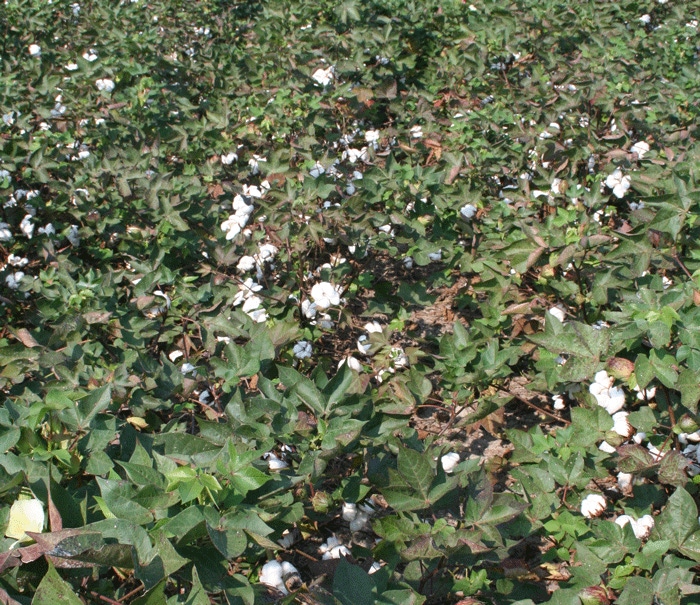April 19, 2011

Long-term research into a sod-based conservation farming system with cattle is showing improved cotton yields and increased soil nutrients following grazing, according to David Wright, University of Florida Extension agronomist.
“This is a long-term project that we have been involved with for about 12 years,” says Wright. “We initially looked at a conventional rotation using conservation-tillage with two years of cotton followed by peanuts with oats as a cover crop compared to rotating a perennial grass through a cotton and peanuts rotation. These were conducted in small plots.”
Researchers went further, he says, and installed cattle into a farming system. “About 25 percent of our row-crop farmers in Florida have cattle. That’s very similar to numbers in Georgia, and Alabama actually might be a little higher. Growers have an opportunity to rotate not only their perennial grasses, but having their winter cover crops as well,” says Wright.
On a 160-acre farm-scale system, the research was begun with 45 cow-calf pairs.
“We found out that was not enough animals on that system to fully utilize the forages we were producing. Initially, on the bahiagrass, we were planting bahia after the winter cover crop in June, and we found that when we over-seeded it early in the first half of the grazing season in January, February or March, then the cattle actually would pack this in and we would have a good stand of bahiagrass later on,” he says.
Where cattle were incorporated, researchers also incorporated rye with oats. In the small plot comparison, only the oats cover crop was used.
About 130 of the 160 acres were irrigated. In each of the quadrants, three exclusion cages were placed. “At anytime, when cattle were on the bahiagrass or the winter grazing, following cotton or peanuts, cattle were not allowed in this area so we could look at the impact of cattle traffic and nutrient recycling, not only on soil properties but on the crops as well,” says Wright.
The exclusion fences were marked with GPS, and as soon as cotton or peanuts was planted, the fences would be taken down so researchers could study the impact on soil and crop properties.
“One thing we looked at initially was the impact from bahiagrass on root mass. Most growers in our part of the world, if they had a crop they could grow anything behind, it would be bahiagrass. One reason for that is that it does reduce nematodes as well as increases organic matter. By the second year of bahiagrass, we’re seeing twice the amount of root mass. We have found that under two-year-old bahiagrass, you have about 20,000 pounds of root mass underneath the crop. With an oat cover crop, you have about 3,000 or 4,000 pounds,” he says.
When researchers strip-tilled with an in-row sub-soiler, it made almost no row because the root mass held the rows together, he reports.
Recycling nutrients
“This is the second year we have looked at the root mass, and down to a meter deep, we have almost twice as many roots from the oat crop following sod as compared to the conventional system. We’re recycling nutrients because the oat roots are able to pick up nutrients from deeper in the soil profile than the conventional rotation, which is the best conservation-tillage we know how to use,” says Wright.
He says yields were measured on cotton, irrigated versus non-irrigated.
“When we first plant, and May is normally dry in the Southeast, the irrigated crop will come up and do well. The non-irrigated looks very poor and stands are slow to establish. But later on, the non-irrigated does catch up. In the smaller plots, for 10 years in a row now, the non-irrigated cotton in the bahiagrass system has out-yielded the irrigated cotton in the standard rotation. A lot of this has to do with the rooting depth and the growth of the roots.”
In the top foot of the soil, he says, there are more nutrients in the grazed versus the ungrazed because cattle are recycling a lot of the nutrients.
“We have about twice the amount of nutrients in the top foot of soil where the cattle are actually recycling the nutrients. Looking at it on a dollar basis, we’re recycling about $120 worth of nutrients over a standard cover crop.”
Looking at yields, in 2007, there was a difference of about 175 pounds of lint where the cover crops were grazed versus not being grazed, says Wright. In the irrigated cotton, there was about 250 pounds more lint than in the non-grazed. In the non-irrigated, the difference was about 450 pounds.
“In 2009, even in the non-irrigated, we made three bales, and conditions were dry.
In general, with small plots and winter grazing, we do have higher yields — two to three to four-bale potential — following bahiagrass with the winter grazing.”
Generally, researchers are getting higher lint yields following grazing and yields were numerically higher in the grazed non-irrigated plots than in non-grazed irrigated plots in normal years, he says. Total nitrogen in the soil and uptake were greater in the grazed plots, grazing winter cover increased cotton yields, and root mass of cotton, peanut and winter grazing were higher following bahiagrass.
About the Author(s)
You May Also Like




